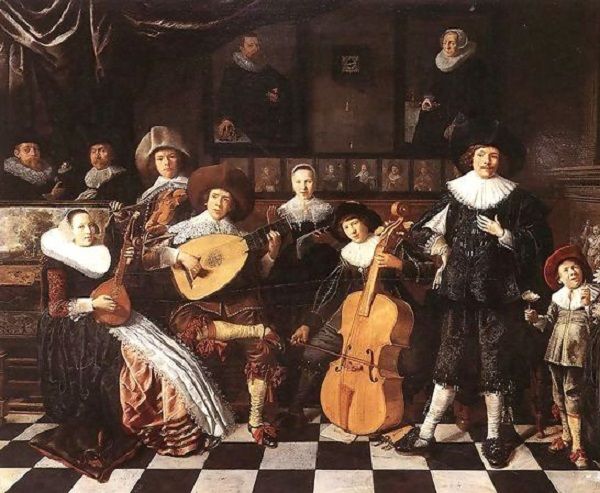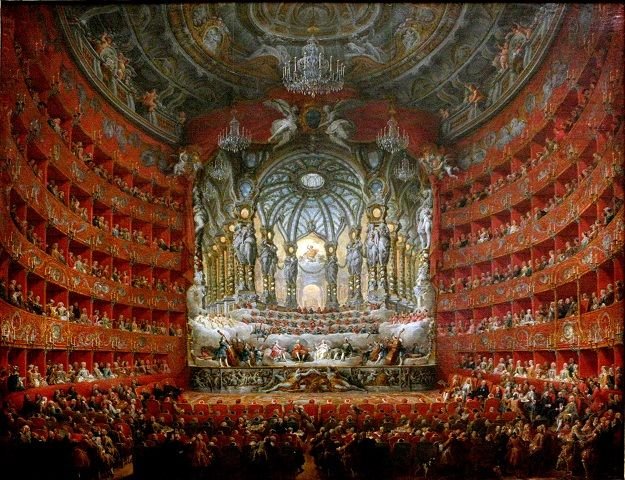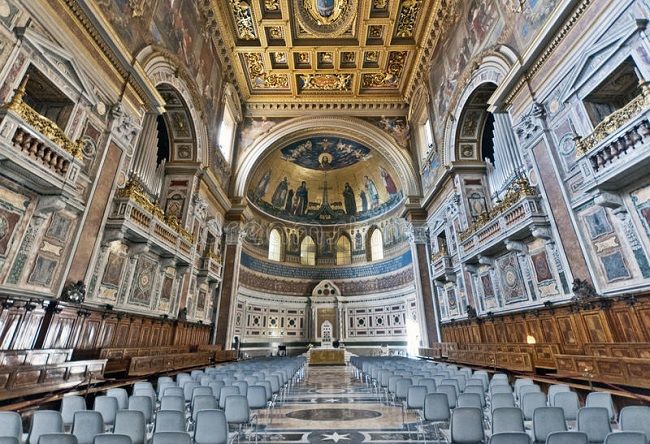The great styles of art: Baroque

The Baroque style originated in Rome at the end of the 16th century and the early 17th century, and has remained a prevailing style in European art for almost two centuries until it was shifted away from Classicalism in the late 18th century. Baroque art has been dramatically, splendidly and impressively evolving in various disciplines of public life and art such as architecture, music, fine arts and sculpture. The popularity of the Baroque is so huge, and its importance is so significant that it is instantly spreading to most of Europe. Baroque art is characterized by often exaggerated actions and the easy-to-understand interpretation of detail that creates a dramatic effect and a sense of scale.

Pannini Giovanni Paolo - Festa Musicale. 1747
Character of Baroque is the sense of majesty in sculpture, paintings, architecture, literature, dance and music
The baroque is evolving rapidly - mainly because of the powerful financial and moral support of the Catholic Church. Its decline, however, puts an end to Baroque and its characteristic features such as grandeur, vitality, drama and sensuality. The baroque is also directly related to the royal power, the aristocracy and the structure of society, which is based on class division. The French Revolution and the emerging ideas of democratic governance have also contributed to the declining influence of Baroque over the years. The earliest and founding factors of Baroque development can be traced back to the early 16th century when the ideas of the Protestant Reformation, led by Martin Luther, began to pave the way across the different countries of Europe. Protestant views call into question some doctrines disseminated by the Catholic Church and questioning its absolutism. The Trent Catholic Church Trent decided to draw up a list of concrete steps by which the Church would oppose the dangerous reform of Rome. The Catholic Church wants in a categorical way not only to return to the religious landscape but also to become the only conductor of Christianity in Europe.

Baroque cathedral, breathtaking interior
It is decided that it is imperative that the Catholic Church begin to train the seculars, most of whom have struggled against illiteracy, in terms of their doctrines. The Trent Assembly decides to use art as a tool for education and propaganda, especially art that is emotionally rich, dramatic, direct and, above all, easy to perceive even by an uneducated person. The need for a powerful and majestic presentation of the ideas of the Catholic Church inspired the creation of the Baroque. The style is a field for many artists from all over Europe who have created many paintings, frescoes, palaces, and so on. Style is different in different European countries depending on their individual religious and political landscape. One of the most famous Baroque architects is Giovanni Lorenzo Bernini (1598-1680), who designed the world-famous St. Peter's Square in Rome. He decorated the square with impressive colonnades to create an analogy with the outstretched hands of the Catholic Church. One of the most famous Baroque artists is Peter Paul Rubens, who is known for his many paintings such as "The Killing of the Infant" and "The Four Continents". Rubens, as well as other baroque artists such as Karavaggio and Giovanni Bernini, are known for their clear, dramatic and artworks that most often present religious themes and stories. In musical terms, the most famous baroque composers include Georg Friedrich Handel and Johan Sebastian Bach.

Ceiling of Sant'Ignazio, Andrea Pozzo 1685. Fresco Sant'Ignazio Church, Rome
Having enjoyed tremendous success throughout Europe, the Baroque began gradually to lose its influence from the late 17th century to the beginning of the 18th century.
The decline in popularity of the style coincided with the fall in the influence of Italy, which is the cradle of Baroque. The styles of Classicalism and Rococo arrive in its place, backed by France, which is the new European force, with which everyone must comply in every respect - political, military, social, and even on subjects such as science and art. The Baroque style is widely criticized and, according to many, it is boring, sprawling, overwhelming, and incapable of reflecting the new realities in public and political life in Europe that brings the wind of change, new ideas, and the destruction of the old system. In France popularity acquires the Rococo style, which I see as a symbol of the resistance against the strict regulations and rules of the Baroque.
I didn't know this is what this style was called. I think this is still alive and well in modern day Prague.
also I noticed that the line
repeats in the first paragraph. I do it too when editing text all the time.
:]
thanks for the inspiration again!
Thank you for the fix.
Yes, it is in Prague. I observe it in some South American authors still write in this style. But Prague will always be a strange town for me. I have not been there, but I have heard stories about Kafka and how this city has changed his mind to write such strange works. Some people have said that there is something schizophrenic in the city that will distort your ideas. :D
it is a strange town indeed, you would love I think. The art galleries I visited there had transformed me in such a massive way, also it was amazing seeing this standard of living that I have seen only in historical contexts to still thrive and continue to develop in a city that is alive today and thriving it seems. Also, everything is surprisingly cheap, compared to other developed countries of course. I did notice a death stare from people when I asked they accept credit cards, and I began wondering if there is a link between the well being of the country and their rejection of credit cards.
I also had this vibe that everyone was in on something, but no one wanted to say what it was. Like Stepford Wives. But it is very magical and it left me wanting other places on earth to be better. I hope you'll get to visit it and share pictures from there. :]
ALSO. they have THE BEST Jesus Christ statue in all of Europe, he is inside the gothic cathedral inside the castle.
Wow, what you describe makes me even more want to go there. :D For me Prague is a literary city. City of Fiction. Like Saint Petersburg in Russia, these are the two cities that inspire writers to translate them into some imaginary language. More imagination than reality. You experience them through the books.
Wow, really informative. Followed and upvoted!
Thank you :)
Such a useful and great story
Thanks :P
Thank you for sharing this!
YOu are welcome :)
Very nic
:)